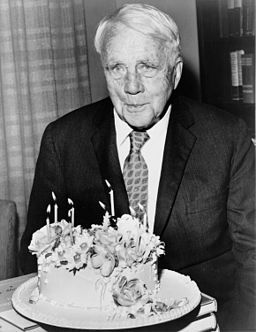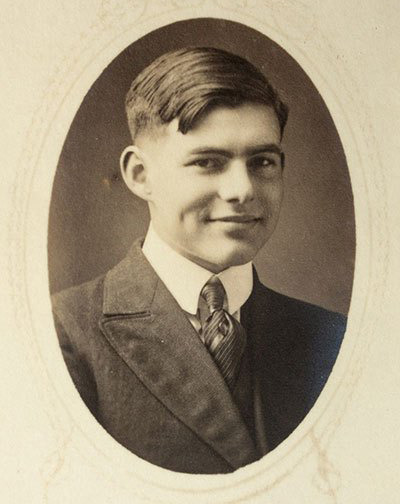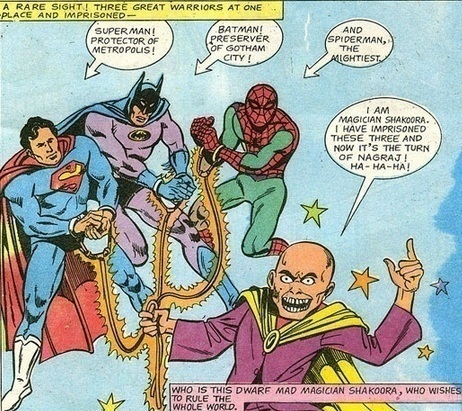The Paris Review's Blog, page 836
March 26, 2013
Happy Birthday, Robert Frost
 “See, I haven’t led a literary life. These fellows, they really work away with their prose trying to describe themselves and understand themselves, and so on. I don’t do that. I don’t want to know too much about myself.” —Robert Frost, the Art of Poetry No. 2
“See, I haven’t led a literary life. These fellows, they really work away with their prose trying to describe themselves and understand themselves, and so on. I don’t do that. I don’t want to know too much about myself.” —Robert Frost, the Art of Poetry No. 2
A Week in Culture: Happy Menocal, Artist
DAY ONE
1 A.M. Go to bed with Mason Currey’s Daily Rituals, a book about the work habits of famous artists, writers, philosophers, musicians, etc. Resolve to have a regimented, productive day tomorrow. All these people seem to subsist on coffee and alcohol and amphetamines. I feel like a toddler with my juice and crackers and noodles.
7:45 A.M. Begin work on a little ad that’s due today for Stubbs & Wootton—fancy slippers made in Spain. It’s for a promotion they’re doing during the Ides of March. Someone at the company started the e-mail chain for the ad with the subject line “Eyes of March,” and I kinda want to do the visual about that. Decide instead to just paint Caesar, wearing the slippers, looking warily over his shoulder. I google “man sitting on column” because I want Caesar to be sitting on a crumbled stump of a column, and find this devil dog.
My husband and I puzzle over where our two thousand terrible black umbrellas have gone, as now it’s raining and we have only one. He doesn’t bring it up this morning, but most times when we’re on the subject John likes to note that the pebbled plastic hook on the common street umbrella reminds him of that embalming tool they used in ancient Egypt to take your brain out through your nose. Read More »
Teen Writers, and Other News
Herewith: writers as teenagers. Only Allen Ginsberg looks suitably awkward.
Feisty indie Inkwood Books, of Tampa, lives to fight another day.
The secret lives of unfinished books.
The uneasy marriage of poetry and e-readers.
Applying science to the Shakespearean authorship mystery.
March 25, 2013
There and Back Again
Since 2003, the Tolkien Society has celebrated Tolkien Reading Day on March 25. Why today, which is neither Tolkien’s birthday, nor Bilbo and Frodo’s? The answer will be obvious to regular observers of the holiday: March 25 marks the downfall of Sauron.
Fair’s Fair: An Interview with Neil Freeman
Way back in 2004, the artist Neil Freeman debuted a novel idea on his Web site, Fake is the New Real: a map of the United States, redrawn so that each state has a more or less equal population. This, Freeman proffered, would correct the current problem with our electoral college system, in which sparsely populated states wield tremendous political influence for no real justifiable reason.
He remade the map in 2010 to reflect current census data, but took the idea to its most exhaustive and visually impressive heights in December 2012. Since the country had just survived yet another election where Ohio and Florida were agreed to be the only states of any import; since the governments of certain conservative-leaning states went out of their way to make voting a nearly constitution-violating ordeal for many minority populations; and since the last few years have seen many congressional districts gerrymandered out of political contention, I was touched by Freeman’s effort to envision an American political process that was, to put it plainly, more fair.
“The states of the United States are too disparate in size and influence,” he introduced the 2012 map. “The largest state is sixty-six times as populous as the smallest and has eighteen times as many electoral votes.” I e-mailed Freeman to discuss his problem with that reality, and how his map could theoretically change it.
You’re pretty vague in the artist’s statement to this piece, saying only “reforms are needed.” What compelled you in 2004 to start this project? What do you ultimately think it says about our politics?
The project grew out of two goals, which have tended to get braided and knotted over time. The first is to visualize the population distribution of the country in a novel way. The second is to critique the electoral college.
The roots of the project go back to the early days of the 2004 presidential campaign. The 2000 election made the limitations of the electoral college painfully obvious. Not only does the system make the popular vote irrelevant, but the college gives different levels of influence and power to citizens of different states based on competitiveness and House apportionment.
There was a fair degree of momentum to reform the electoral college after the 2000 election, and nothing happened. The electoral college is deeply naturalized into our political narrative, and rational discourse seems to have little ability to dislodge it. I hope that a more creative approach to the electoral college helps to lay bare its shortcomings and the possibility of effective reform.
Presidential campaigns are also a moment when everyone pays close attention to maps of states, and the weaknesses of state maps as a visual tool become apparent. After the 2000 and 2004 election, a county-by-county map that showed that the country as a mostly red country with little blue bits on the coast began showing up as a proof of the irrelevance of the Democratic vote. This is downright silly, and it really saddens me that people confuse geographical space with population density. If—when—we get rid of the electoral college, one of the benefits will be the irrelevance of geographical state-by-state maps for illustrating campaign trends.
To tie that up—by redrawing the political map, I hope to draw attention to the limitations of our political system, and the ways that we commonly represent it. Read More »
Happy Birthday, Flannery O’Connor
“I don't deserve any credit for turning the other cheek as my tongue is always in it.”
—Flannery O’Connor
Elijah Returns
 A holiday’s most assiduously followed rituals occur, usually, before the holiday itself: preparing the customary meal, shopping for the requisite gifts, configuring the most acceptable seating arrangements. So much must happen before the sun goes down and the first three stars appear in the sky.
A holiday’s most assiduously followed rituals occur, usually, before the holiday itself: preparing the customary meal, shopping for the requisite gifts, configuring the most acceptable seating arrangements. So much must happen before the sun goes down and the first three stars appear in the sky.
During the month preceding Passover, my father spends several hours planning, revising, and rerevising his remarks for our family’s seder. It’s a tradition that began a few years ago, when his father, deaf and grumpy with age, decided to pass on the task of leading the premeal service. An attorney familiar with speaking in courtrooms, my father is meticulous with his preparations—offhand-seeming ums and you knows are carefully drafted; a stopwatch ticks as he practices his commentary. Generally his seders have been regarded as both witty and efficient, observing all the rituals while getting us quickly to the meal.
But last year didn’t go so seamlessly. As the holiday approached, he was nervous because, for the first time since their divorce, my mother had decided to host the seder. As she has no immediate family in Minneapolis (except her devoted, sympathetic son), this meant fourteen of her former in-laws would convene in her home—a home she shared with her new husband, Kevin, a Catholic from North Dakota whose existence my father was uneasy about.
“I’m not quite sure how to handle it,” he said to me the week before the seder. Read More »
Indian Comics, Professor Nabokov, and Other News
You must begin your week by looking at this list of head-scratching moments from Indian comics.
“Facing him on the stage was his white-haired wife Vera, whom he identified only as ‘my course assistant.’” In Professor Nabokov’s classroom.
In light of the matter of Wikipedia plagiarism, Jane Goodall’s book has been postponed.
The very first ad for Winnie the Pooh.
Remembering the Warner Sisters, “America’s answer to the Brontës.”
March 23, 2013
Here We Are: On the Occasion of Philip Roth’s Eightieth Birthday
Upon the occasion of Philip Roth’s eightieth birthday, acclaimed critic and biographer Hermione Lee likened the newly retired writer first to Shakespeare and then to one of his creations, The Tempest’s Prospero, who famously invokes the audience’s applause as a means to his freedom. But surely, not even Prospero enjoyed such applause as Mr. Roth received on his birthday night, as family, friends, and fans gathered at the Newark Museum on Tuesday evening to honor the literary legend. Dressed in their party best, yet casual and comfortable (no black ties here), guests at the invitation-only celebration—including Philip Gourevitch, Jonathan Safran Foer and Nicole Krauss, Library of America’s Max Rudin, official Roth biographer Blake Bailey, and many dedicated Roth scholars and members of the Philip Roth Society—perused collections of American and Tibetan art and visited the nineteenth-century home of the Ballantines, then mingled in the museum’s airy classical court, pacing the marble floors, conversing, sipping sodas and sparkling water, and nibbling on hors d’oeuvres and crudités before moving to the auditorium for a program of tributes and speeches. Read More »
March 22, 2013
We Have a Winner!
A few weeks ago, we asked you to send us your best portrait-of-the-artist-as-a-young-person photos for a chance to win a Frank Clegg briefcase. Read on for a slideshow of exceedingly sensitive finalists … and one gloriously pretentious winner!
Third Place
This would be mid- to late eighties. I had just finished writing my first novel, calling it Bad Girls of Ireland. I would like to note, for the record, that while the book remains unpublished, I stand firm in my belief that it was the first to wear that “bad girls” label which became a thing in the early nineties (before we had memes, kiddies).
At the time I thought it was an appropriately high/low moniker to slap on two hundred pages that were (let’s be honest) too esoteric to be legible to anyone else on earth; in retrospect it sounds kind of cheesy. I think you had to be there. Influences? Joyce, naturellement. Nabokov, Calvino, Rilke, Duras, Cortázar, all of those Zone books about the body. Jung! Was I a mo girl swimming in a pomo stream, or the reverse? From the outside my life looked way more like a Tama Janowitz story than the Kathy Acker one that was going on in my head, right down to the jewelry-selling on the street. Earrings—singletons only, made out of broken glass I collected at bus stops. Some insufficiently considered “performance art.” You get the picture. Read More »
The Paris Review's Blog
- The Paris Review's profile
- 305 followers











